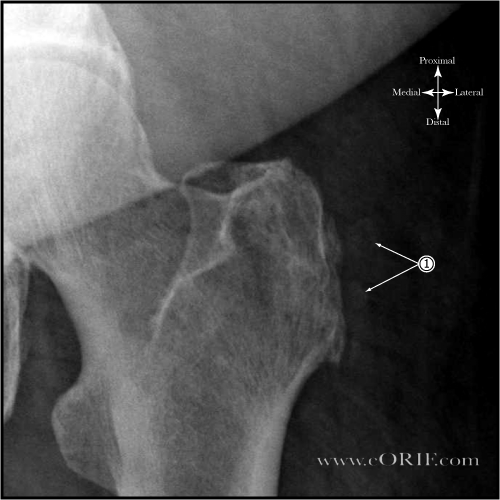 |
synonyms:hip bursitis, greater trochanteric pain syndrome, trochanteric bursitis
Greater Trochanteric Bursitis ICD-10
Greater Trochanteric Bursitis ICD-9
- 726.5 (Enthesopathy of the hip region)
Greater Trochanteric Bursitis Etiology / Epidemiology / Natural History
- Results from friction between the greater trochanter and the iliotibial band during hip flexion and extension causeing microtrauma and bursal inflammation.
- Chronic greater trochanteric bursitis can lead to a painful limp and sleep difficulty
- Common: 5.6 patients per 1000 adults.
Greater Trochanteric Bursitis Anatomy
- The trochanteric bursa lies between the iliotibial band and the greater trochanter.
Greater Trochanteric Bursitis Clinical Evaluation
- Pain and tenderness over the affected greater trochanter. Pain is often worse when first rising from a seated / recombent position.
- Increased pain with adduction and internal rotation.
- Generally unable to lie on affected side.
- Pain may radiate into the buttock or down the leg into knee or ankle.
Greater Trochanteric Bursitis Xray / Diagnositc Tests
- A/P pelvis, A/P and lateral of the affected hip. May demonstrate rounded or irregular calcific deposits around the greater trochanter.
- MRI indicated if patient fails to improve with conservative managemet to evaluate for Gluteus medius tear or other hip pathology. Also consider MRI / bone scan if concerned for occult fracture or tumor.
Greater Trochanteric Bursitis Classification / Treatment
- Initial treatment: physical therapy, NSAIDs, ICE, corticosteriod injection, short term cane use, weight loss. >90% successful, but recurrence is common.
- Consider PRP injection (Walker-Santiago R, Arhtoscopy 2019)
- MRI indicated for patients who fail conservative management to evaluate for partial of complete tendon ruptures.
- Chronic Recalcitrant: open or arthroscopic bursectomy.
- Arthroscopic bursectomy: proximal portal just posterior to the tip of the trochanter. Distal portal just posterior to the inferior aspect of the bursa. (Baker, CL)
Greater Trochanteric Bursitis Associated Injuries / Differential Diagnosis
- Gluteus medius tears, found in up to 22% of elderly patients.
- Lumber degenerative disc disease
- Lumbar spinal stenosis
- Hip arthritis
- Limb-legth discrepancy
- Painful hardware (after ORIF of hip fractures)
- Metastatic tumor
- Sciatica
- Septic arthritis
- Snapping hip (Coxa Saltans)
Greater Trochanteric Bursitis Complications
- Greater trochanteric bursitis injection risks: infection, allergic reaction to local anesthetic or steriod preparation, fat atrophy, skin depigmentation
- Hip Bursitis injection: 2cc dexamethasone, 4cc marcaine, 4cc lidocaine.
- Surgery complications: recurrent external snapping hip, retears resulting from falls, trochanteric fracture, venous thrombosis, and wound-related problems.
- Chronic pain
- Limp
- Difficulty sleeping
Greater Trochanteric Bursitis Follow-up Care
- May consider repeat injection if initial injection fails or symptoms return. Avoid multiple steriod injections.
Greater Trochanteric Bursitis Review References
- Karpinski M, Piggott H. Greater trochanteric pain syndrome. A report of 15 cases. J Bone Joint Surg Br. 1985;67:762–763. [PubMed]
- Radin E. Biomechanics of the human hip. Clin Orthop Relat Res. 1980;152:28–34. [PubMed]
- Bunker T, Esler C, Leach W. Rotator-cuff tear of the hip. J Bone Joint Surg Br. 1997;79:618–620. [PubMed]
- Wright J, Swiontkowski M, Heckman J. Introducing levels of evidence to the journal. J Bone Joint Surg Am. 2003;85:1–3. [PubMed]
- Farmer K, Jones L, Brownson K, et al. Trochanteric bursitis after total hip arthroplasty. J Arthroplasty. 2010;25:208–212. [PubMed]
- Furia J, Rompe J, Maffulli N. Low-energy extracorporeal shock wave therapy as a treatment for greater trochanteric pain syndrome. Am J Sports Med. 2009;37:1806–1813. [PubMed]
- Govaert L, van der Vis H, Marti R, et al. Trochanteric reduction osteotomy as a treatment for refractory trochanteric bursitis. J Bone Joint Surg Br. 2003;85:199–203. [PubMed]
- Iorio R, Healy W, Warren P, et al. Lateral trochanteric pain following primary total hip arthroplasty. J Arthroplasty. 2006;21:233–236. [PubMed]
- Rompe J, Segal N, Cacchio A, et al. Home training, local corticosteroid injection, or radial shock wave therapy for greater trochanteric pain syndrome. Am J Sports Med. 2009;37:1981–1990. [PubMed]
- Slawski D, Howard R. Surgical management of refractory trochanteric bursitis. Am J Sports Med. 1997;25:86–89. [PubMed]
- Baker CJ, Massie R, Hurt W, et al. Arthroscopic bursectomy for recalcitrant trochanteric bursitis. Arthroscopy. 2007;23:827–832. [PubMed]
- Kagan A. Rotator cuff tears of the hip. Clin Orthop Relat Res. 1999;368:135–140. [PubMed]
- Lequesne M, Djian P, Vuillemin V, et al. Prospective study of refractory greater trochanter pain syndrome. MRI findings of gluteal tendon tears seen at surgery. Clinical and MRI results of tendon repair. Joint Bone Spine. 2008;75:458–464. [PubMed]
- Voos J, Shindle M, Pruett A, et al. Endoscopic repair of gluteus medius tendon tears of the hip. Am J Sports Med. 2009;37:743–747. [PubMed]
- Davies H, Zhaeentan S, Tavakkolizadeh A, et al. Surgical repair of chronic tears of the hip abductor mechanism. Hip Int. 2009;19:372–376. [PubMed]
- °
|

